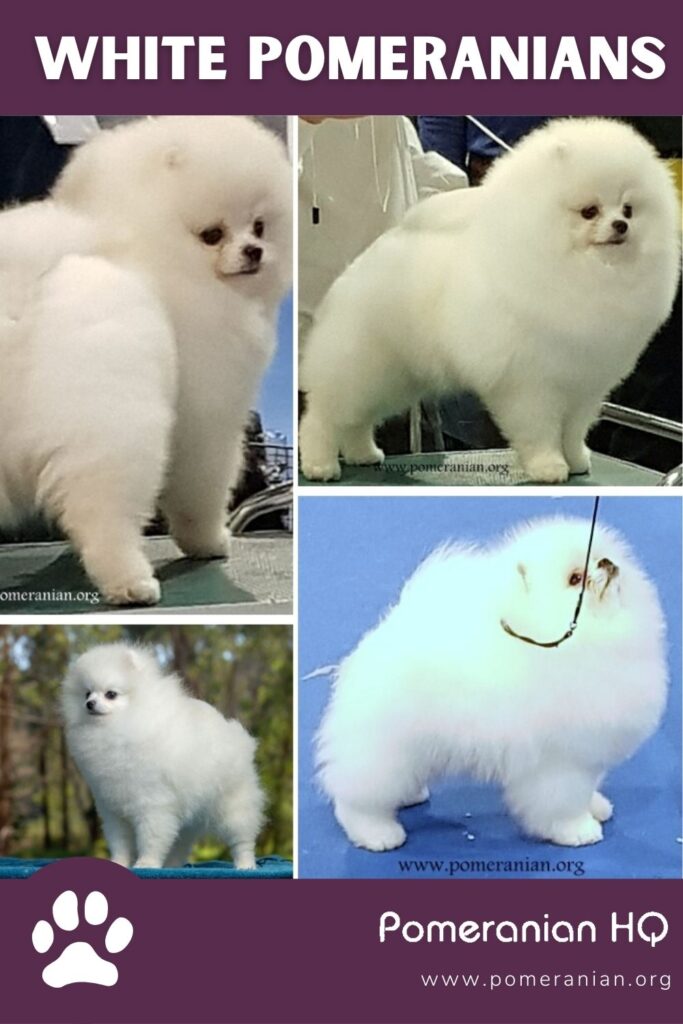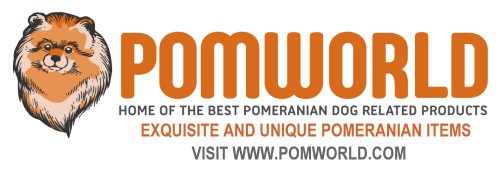Last Updated on 09/02/2024 by Denise Leo. Post first published on May 13, 2022.
A simple glance at any white Pomeranian, and you’ll immediately fall in love. You will immediately want to bend down, scoop him up in your hands, and start cuddling him for the rest of the day.
White is among the most outstanding Pomeranian colors, making it impossible to resist when your eyes spot such an adorable fluffy ball of joy.
White Pomeranian puppies usually have ice-white fluffy coats and cute little faces with bright, dark, almost black, almond-shaped eyes. Who could resist cuddling one of these little darling Pom puppies?
What is a White Pomeranian?
An all-white Pomeranian dog should be a solid white color with no lemon or cream shadings. The guard hairs and the undercoat are also white. White Pom dog eye color must be very dark, if not black. The breed standard calls for dark eyes, not black eyes.
Adult white Pomeranian dogs must have black points, i.e., black eye rims, a black nose, lips, and paw pads.
Newborn white baby Pomeranians are ice white with all pink points. By the age of six weeks, these points should have darkened to black; however, the coat will remain snow-white.
White Pomeranian Facts
- A true white Pom dog should appear to be snow white.
- The white Pomeranian color is one of the original breed colors.
- The first Pomeranian champion was a white Pom, Champion Rob of Rozelle.
- White Pomeranians are recognized by all kennel clubs worldwide.
- Newborn Pomeranian puppies often appear to be white but may mature to be cream or orange Pomeranians.
- True show quality; ice white Pomeranians are rare.
- There are two types of white Pomeranian dogs.
- White Pomeranians may grow larger than show size.
- White Pomeranian puppies often do not stay white.
- White pom puppies have pink points ( i.e., nose, eye rims, and pads) at birth.
- The prices asked for white Pom puppies are often higher than those of other colored puppies.
- Eye stains are often an issue with white Poms.
White Pomeranian Video
View the video of the white poms bred here at Dochlaggie Pomeranians. A fluffy white Pomeranian puppy, newborn Pomeranian puppies to 6 weeks old. White baby Pomeranian puppies I have bred happy playing with toys.
Why Pure White Pomeranians Are So Different from Most!
The Pomeranian is already a regal toy breed. When you add fluffy fur whiter than snow to this creature’s unique personality, you’ll fall under the enchantment of this rare beauty that would be equally at home in the pages of any fairy tale book.
You probably wonder… why is a white Pomeranian so different from others of the breed and what makes it extra special? You also want to know how to get one of these vivacious, white snowballs.
Ice white, show-quality toy breed Pomeranians are indeed a rarity. Each one is carefully bred to ensure the quality of the snow-white fur without losing any of the overall high quality of the Pomeranian’s breed type.
A genuine show-quality American Kennel Club white Pom is usually the painstakingly crafted offspring of many generations of careful breeding.
We’ll discuss breeding ice-white, show-quality Pomeranians in-depth later in this article and why many show breeders give up on this challenging task.
There Are 2 Types of Pure White Pomeranians
Pomeranian owners and Pom breeders need to understand two types of white Poms.
White Pomeranian dogs bred from parti colors will always be a parti Pomeranian, even if you can’t see the parti patches as they’re so small, and the dog appears to be a Pomeranian white dog in appearance.
The other type of white Pomeranian dog is an extremely pale cream Pomeranian. This important Pomeranian fact makes the task for any white reputable Pomeranian breeder very difficult.
Will A White Pomeranian Puppy Stay White?
Unfortunately, the answer is usually no! It can be difficult to determine the full-grown white Pomeranian color of an all-white baby Pomeranian until after the coat changes at around six months.
Always look at the hair at the back of the pup’s ears. Is there any color other than snow white? If there are light orange or biscuit shadings behind the pup’s ears, the dog might be particolored, cream, or even an orange Pom dog.
Snow White Pomeranian Puppies Color Changes
Cream, Orange, White Parti Colors, and Light Orange, young Pomeranian puppies are frequently erroneously described as white baby Pomeranians.
Biscuit or cream hair behind the pup’s ears usually means the white baby Pomeranian will turn out cream or a very light orange Pomeranian and is not an ice white pomeranian with a pure white coat.
Small light biscuit patches on the pup’s coat may indicate the Pomeranian white puppy is a parti-colored Pomeranian and won’t be an adult white Pomeranian.
Always purchase your puppy from a reputable Pomeranian breeder. If purchasing your puppy as a real white Pomeranian puppy, request written assurance that the pup will be this color as an adult.
Are White Pomeranians Rare?
Is an all-white Pomeranian dog a rarity? Yes, true show quality, ice-white Pomeranians can be considered rare.
How Much are White Pomeranian Puppies?
A true white Pomeranian puppy will be priced from $4000 upwards. The white Pomeranian price is usually more expensive than an orange Pomeranian puppy of the same age and quality.
Owing to the simple fact of supply and demand for baby white Pomeranian puppies, the white Pomeranian cost can often be double that of a standard colored Pomeranian.
The most common Pomeranian scam involves advertising white Pomeranian puppies for sale, usually a Pomeranian puppy white female, which does not exist.
Of all the Pomeranian colors, white seems to be the most in-demand by people looking for a beautiful pet dog.
Breeders receive many inquiries for white Pom puppies. Many white Pomeranian enthusiasts often search for white toy Pomeranian puppies, pure white teacup Pomeranian puppies for sale, or white miniature Pomeranian puppies.
I receive many emails daily asking if I have a Pomeranian white puppy or all white Pomeranian puppies for sale.
Other queries include asking if I have white toy Pomeranian puppies, white mini Pomeranian pups, or white miniature Pomeranian dogs available.
The reality is all Pomeranians are classed as toy dogs, as they are shown in the toy group at shows together with other toy-sized dogs. The actual terms white micro teacup Pomeranian, teacup Pomeranian puppies, and miniature Pom are simply sales gimmicks to trap the naive.
People searching for a white baby Pomeranian puppy additionally require information regarding the price of the white Pomeranian puppy.
Where Can I Buy a Fluffy White Pomeranian Puppy?
People looking to buy a white puppy should contact a reputable Pomeranian breeder. Unfortunately, there are lots of internet scams involving white Pomeranian puppies.
The most common Pomeranian scam involves advertising white puppies for sale, usually a Pomeranian puppy white female or a white teacup Pomeranian.
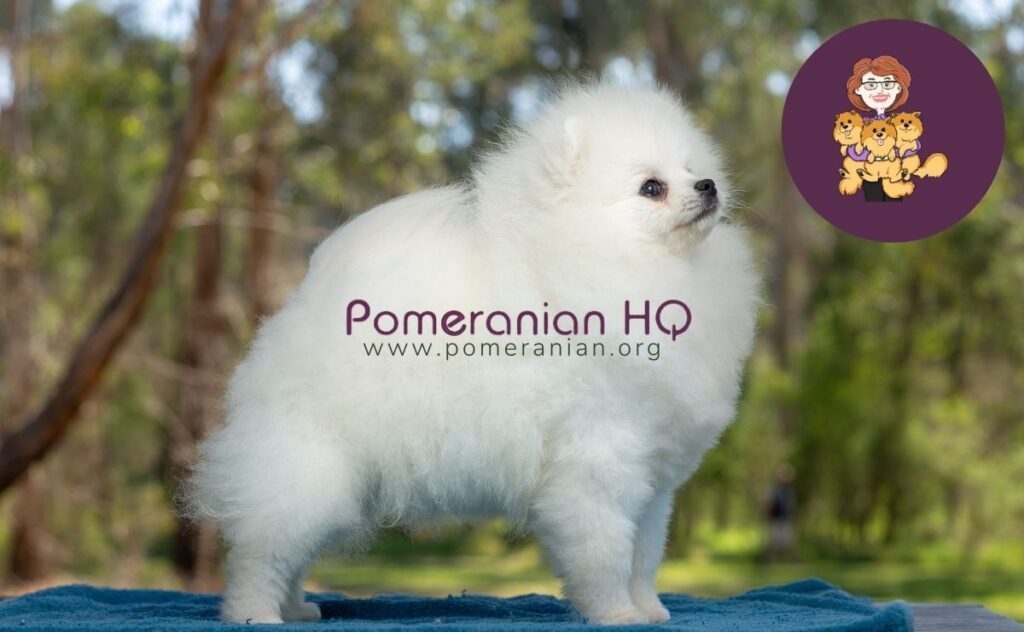
Is Owning a White Pom Puppy a Wise Choice for Me?
A white Pom might be ideal if you already adore Pomeranians but want a unique dog. However, the price might be higher because they’re scarcer than you’re willing to pay.
White Pomeranian Grooming
It’s important to appreciate that Pomeranian ownership requires a big commitment to maintenance and grooming. A white-colored Pom needs more care when looking after his coat, including tear stains.
White Pomeranians need more care and maintenance than their colored counterparts simply because it’s much more difficult to ensure their coats don’t become stained permanently. That swift action is needed the moment they get any marks at all.
White Puppy Pomeranian Grooming and Care
There are a few aspects of his coat that will require constant focus:
1. Tear stains are more obvious on a white coat than on any other color combination. All Pomeranian dogs have some degree of eye stains called Pomeranian tear stains. Unfortunately, these stains are more obvious on light-colored dogs. Pomeranian eye stains can be easily removed and prevented with proper care.
Pomeranians are susceptible to tears staining their coat, so you should make it a daily ritual to wipe around their eyes. Choose a good quality wipe designed for dogs, only use filtered water because it’s clean, and choose an Eye Envy Tear Stain Remover to protect the hairs near their eyes from turning an unpleasant, dirty color.
- 30-45 DAY SUPPLY KIT: The Tear Stain Remover Pack contains 2 oz Tear Stain Remover Solution for Dogs, .5oz Tear Stain Remover Powder, 30-Count Applicator Refill Pads, and Small or Large ProPowder Applicator Brush.
- TWO-STEP SYSTEM: Tear Stain Solution cleans the affected area and helps fight the root cause of the staining; apply with included applicator pads. Tear Stain Powder absorbs excess moisture and helps repel new tears. It is NOT a chalk or cover up, but a natural silk-like powder that safely keeps your pet’s eye dry, stain-free and full of luster. Apply Powder safely with the ProPowder Brush.
- REMOVE TEARS: Safely remove tear stains with non-irritating and 100% natural ingredients including Colloidal Silver. Remove tear stains in 7 days with daily use. For tear free eyes, use weekly once original tear stains are removed. Apply directly around the eyes and between skin folds.
- SAFE AND NATURAL: Eye Envy products are non-irritating and applied topically, never ingested. Eye Envy does not contain; parabens, peroxide, bleach, or steroids. Safe for pets of all ages. Made in USA with human grade ingredients since 2001.
- EFFECTIVE ON WHITE DOGS/WRINKLED BREEDS: Proven effective by breeders, veterinarians, professional groomers and dog show enthusiasts worldwide. Maltese, Shih Tzu, Cavalier King Charles Spaniel, Havanese, Bichon, Poodle, Samoyed, Pekingese, Pomeranians, Pugs, Bulldogs and other white/light colored toy breeds.
2. On a white Pom, any hair hanging from his ankles will collect all debris, dirt, and dust; of course, it will stand out for the world. Trimming around his paws and lower legs is wise because he should retain his white coloring.
3. After he has been outside, whether for a toilet break or a walk, wipe his lower legs and paws with a dog wipe. An easy way to do this is to store a box by the front door so he can stand in it while you clean him before allowing him to romp free through the house.
Some white Pom owners have a cleaning spray that lets them clean particular body parts without giving them a full-blown bath. Trimming his fur around all paws helps reduce the amount of dirt he can collect.
A bath should only be done once every two to three weeks because a greater frequency can dry his skin too much. Poms are fairly easy to groom. Brush the thick double coat twice weekly with a pin brush and a slicker to ensure his coat is healthy and fluffy.
A little extra time is required in a grooming regime for an ice-white Pomeranian. Special shampoos may be needed to keep the coat a sparkly ice white, and tear staining is often a problem with the White Pom.
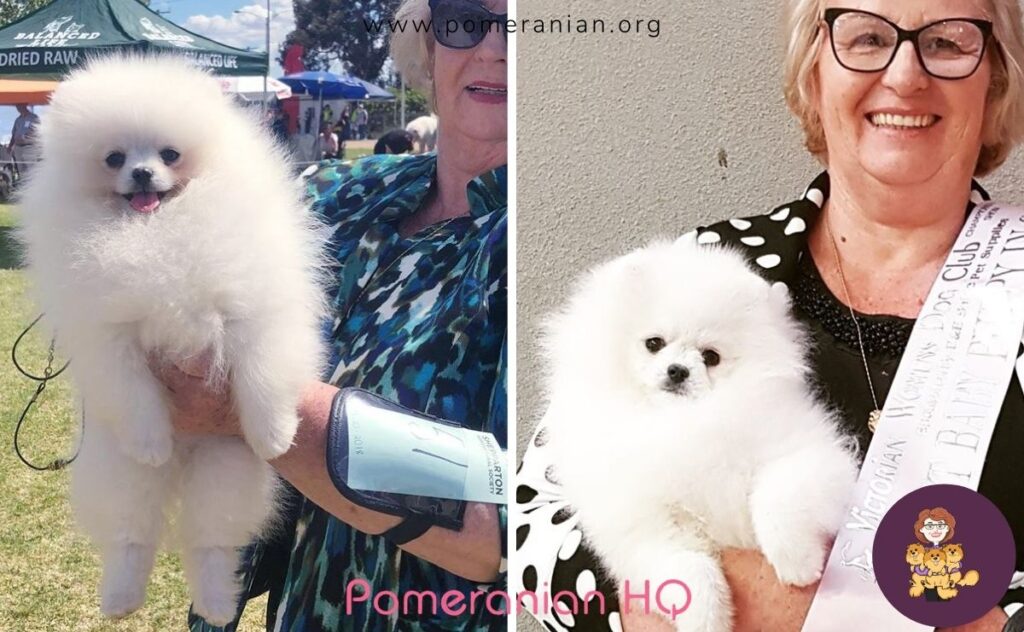
Staining from food on the face and feet can also be removed by using the same products.
White Pomeranian Size
A question I am asked a lot of time is how big do white Pomeranians get? The white Pomeranian is a toy breed, and the size of a white Pom dog should be as stated in the Pomeranian breed standard.
The AKC Pomeranian standard dog generally weighs between 3-7 pounds, and his height is usually about 20 cm ( 8 inches) from the floor to the top of his withers (shoulder blades). He’s recognized as a compact breed, but his fur gives him a bigger look.
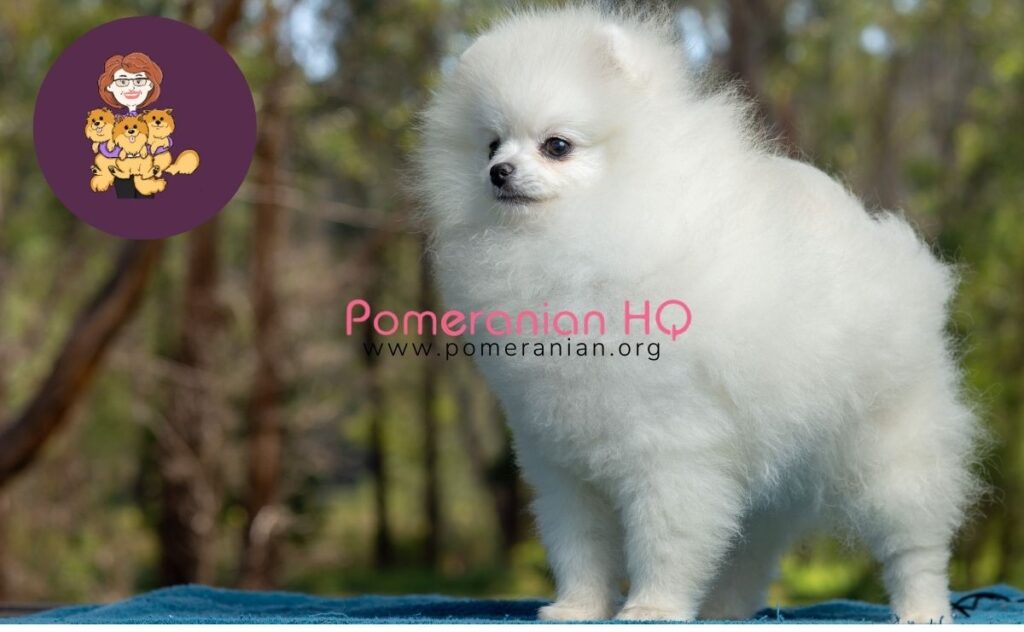
The white puppy Pomeranian size can often be bigger than the traditional orange and orange sable Pomeranians. White Pomeranian owners are often disappointed when their tiny white Pomeranian puppies grow into large Pomeranian adults.
You can all love a standard Pomeranian or a large Pomeranian, but it’s wise to do your research if you want a specific sized Pom, or you may end up feeling quite disappointed at the end result once your dog has grown into adulthood.
The white Pomeranian is usually classed as an exotic Pomeranian color. The colors known today as the original used to be regarded as exotic.
Today’s exotic-colored Poms frequently develop differently from the dogs that show standard today.
American Kennel Club Pomeranian breeders generally focus on breeding Kennel Club Pomeranian standard colors. Many decades of hard work by preservation breeders have contributed to the quality orange and orange sable Pomeranians now gracing the show rings.
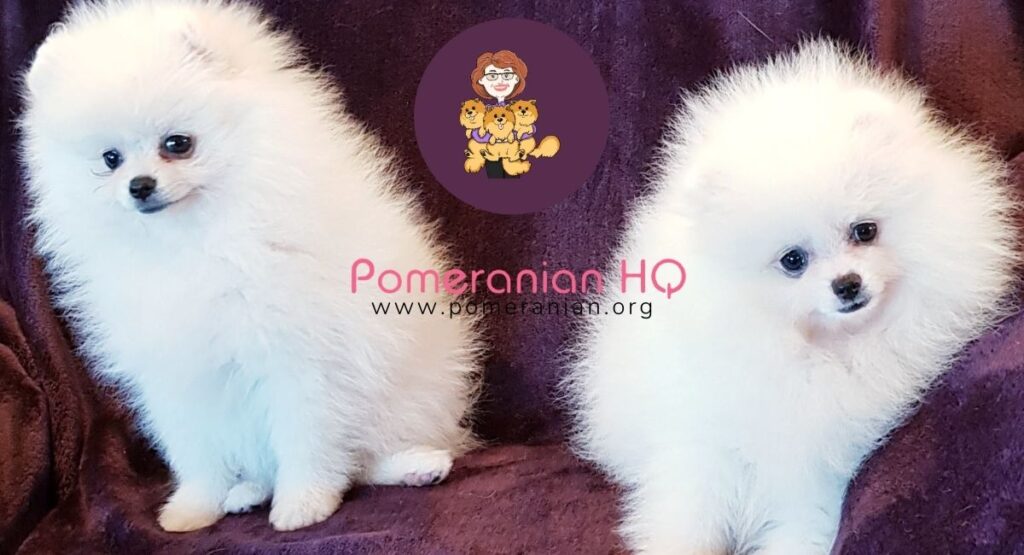
Show Pomeranian breeders often give up efforts to breed show-quality exotic Pomeranians after many years of frustration.
At Dochlaggie Pomeranians, I have been breeding white and particolored Pomeranians for many decades and feel the pain and frustration at the slow results. White Pomeranians quickly revert to the older style of Pomeranian in type and size.
White Pomeranian puppies may look tiny and adorable at eight weeks but do not be surprised if your tiny white Pomeranian puppy matures into a large pale cream Pomeranian that may be too much to handle if you weren’t prepared.
White Pomeranian Health Problems
White poms are prone to the same health issues as other Pomeranians and have a similar lifespan. Pomeranians have an average lifespan of 12 – 16 years, meaning you don’t need to worry about falling in love with a bundle of fur and fear that he won’t live long.
You must buy your new bundle of joy from a reputable breeder. Then, you’ll have confidence that he has been cared for properly, greatly contributing to how long he’s likely to live.
This will help stop him from suffering from certain hereditary health troubles. Although Pomeranians are regarded as a healthy breed, there are certain health issues they’re more likely to face:
- They can suffer from a collapsed trachea, creating a blockage in their airways. Symptoms may include heavy breathing, making a raspy noise, and coughing.
- Another problem is black skin disease or alopecia x. This isn’t curable, but the only harm to the dog is his looks because his fur falls out and his skin turns black.
- Several joint problems are common occurrences. A loose kneecap (a luxating patella) can cause the dog agonizing pain. Hip dysplasia is another joint problem that is rare in the Pomeranian.
- White dogs sometimes have hearing problems, so to avoid this, it’s wise to take your dog to get his hearing tested. Hearing issues are a health issue related to many white dogs regardless of breed. As a white Pomeranian breeder for many decades, I have not come across a deaf white pom. On the other hand, I have heard of deaf Pomeranians in various colors.
- Other health problems you must be mindful of are hypoglycemia, hypothyroidism, distichiasis, and entropion.
You should purchase your puppy from a reputable breeder who does health testing and proves their poms in the show ring before breeding. Ask your breeder to have the hearing of a Pomeranian white puppy checked before purchase.
White Pomeranian Temperament Insights
The following applies to all Pomeranians regardless of their coat color:
A Pomeranian won’t be a good idea if you want a dog that’s not vocal. But, if you’re looking for a canine who will notify you when anything suspicious occurs (along with some things that aren’t suspicious at all), then you can’t go past a white Pom as a choice for a new household member.
Bear in mind, however, that if you have young children, Pomeranians are an active breed, and young kids cannot be a good mix. So, it has to be a consideration if your children are very young.
You must socialize any dog you bring into your home, regardless of size. The bottom line is to do your due diligence before buying because canine ownership is for life, not merely for a whim.
Breeding White Pomeranians
If you are interested in how to breed snow-white Poms and enjoy a good challenge, then the white Pomeranian is for you.
Many breeders have attempted to breed show-quality small white Pomeranian dogs. The only successful white breeders have concentrated solely on the white Pom. Over the years, numerous breeders have tried and quickly given up on this challenge.
White-to-white breedings can quickly produce problems, including Poms, whose quality has reverted to the old style or original Pomeranian type, loss of pigmentation, lacking head and leg coat, poor coat quality, and more.
A study of old pedigrees will reveal past reputable Pomeranian breeders gave up on breeding the ice white Pom and used their white Pomeranian girls to better advantage in an orange breeding program.
My Recommendations Related to White Coat Color Breeding Programs
Based on my personal experience over many decades breeding white Pomeranians, I recommend the following:
When mating for Pomeranian puppies white, the ideal to pair is pure white Pomeranian with white; white with black (as long as the black has white close in its pedigree; white with cream; white with parti (preferably black parti, i.e., a Pomeranian black and white), and white with wolf sable or a cream sable.
White Pomeranian Color Breeding Don’ts
I don’t suggest you breed a white pom with a chocolate sable or a chocolate Pomeranian. Also, do not breed a white Pomeranian with an orange Pomeranian if possible. Never mate an adult white Pomeranian with a beaver pom dog.
History of The Pomeranian White Dog
The early Pomeranian dogs were mostly white-colored. Unfortunately, these dogs were also rather larger than desired and more German Spitz dog type or sled dog in appearance than the modern-day Pomeranian.
These larger white dogs had long, narrow muzzles, lower set tails, flat open coats, bigger ears, and were often longer backed than the breed standard demanded.

Orange, sable, blue, and chocolate Poms appeared in the Pomeranian dog world, and the breeders of these older-style white dogs attempted to breed their dogs down in size by outcrossing with the newer colored dogs. The resulting progeny was usually parti-colored or wolf-sable in color.
Those white Pomeranian breeders who attempted to breed the whites down in size faced problems with pigmentation, coat texture, and retaining the ice-white coat color.
Many dogs had problems with lemon shading and tippings to their coats. Even today, the UK Kennel Club’s reputable breeders attempting to breed ice white Poms of show quality face tremendous hurdles.
White is One of the Original Pomeranian Colors
The original Pomeranian colors were White, Black, and Cream, and occasionally a parti-color was seen. It was not until Queen Victoria visited Italy and bought back different colored Poms that other colored dogs appeared in the breed.
Bred by Miss Hamilton, who specialized in white Pomeranians. Champion Rob of Rozelle was also the sire and grandsire of many champion dogs during this era, including another white champion for the breeder, Miss Chell, Champion Belper Flossie.
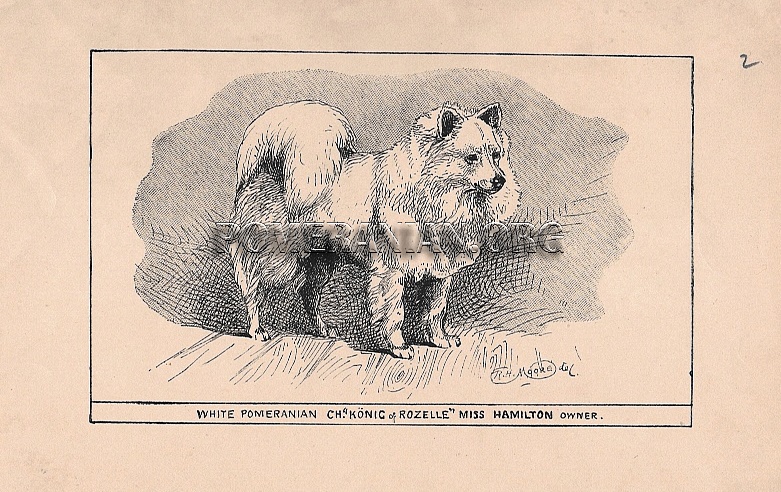
The second Pomeranian Champion was another white Pomeranian dog, Champion Konig of Rozelle. Konig was a son of Champion Rob of Rozelle. The dam was Peggoty.
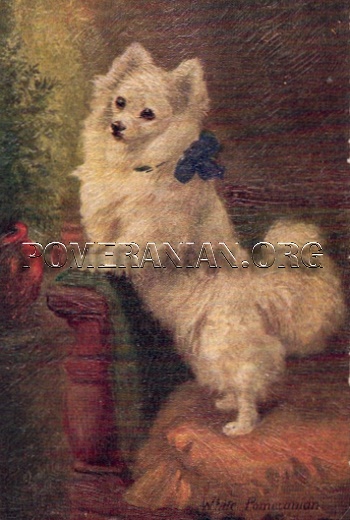
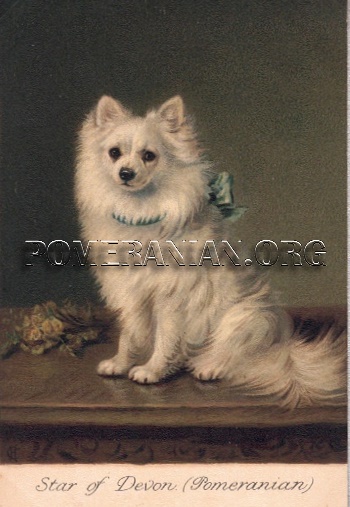
As one of the original breed colors, Kennel Club recognition is worldwide for this colored Pomeranian dog.
Final Thoughts on White Pomeranian Dogs
The white Pomeranian is a small breed of dog that has been around since the 1800s. They are typically very fluffy and have long, thick hair. White Teacup Pomeranian puppies love to play games with their humans and will do anything to get their attention.
White poms also tend not to shed as much, so if your allergies are an issue, this might be great news. If you’re considering bringing a white Pomeranian into your home and want to know more, this article will give you the information you need to make an informed decision.
Pictures of White Pomeranian Puppies
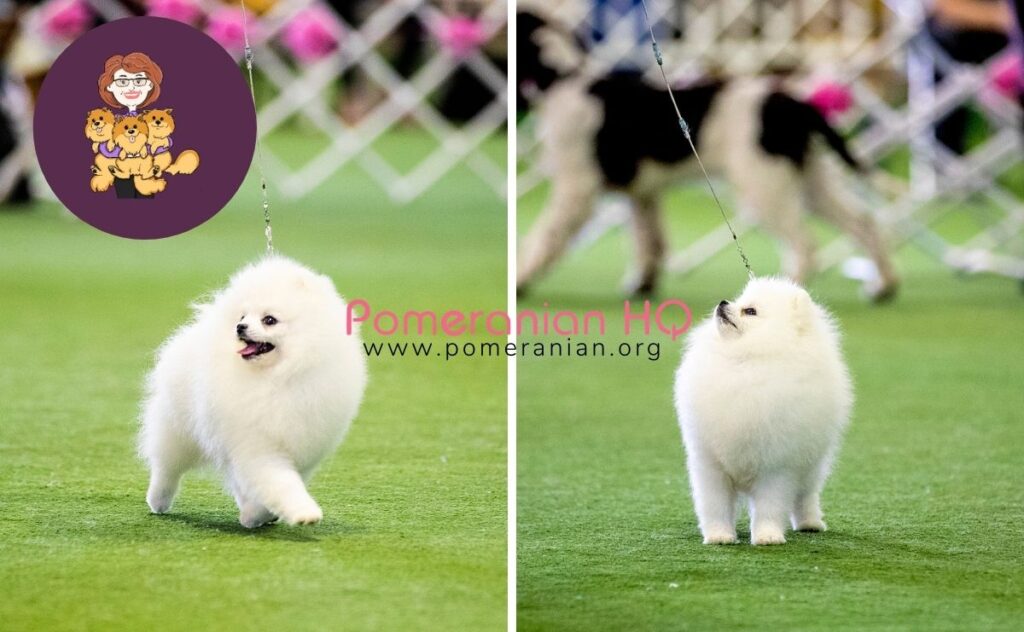
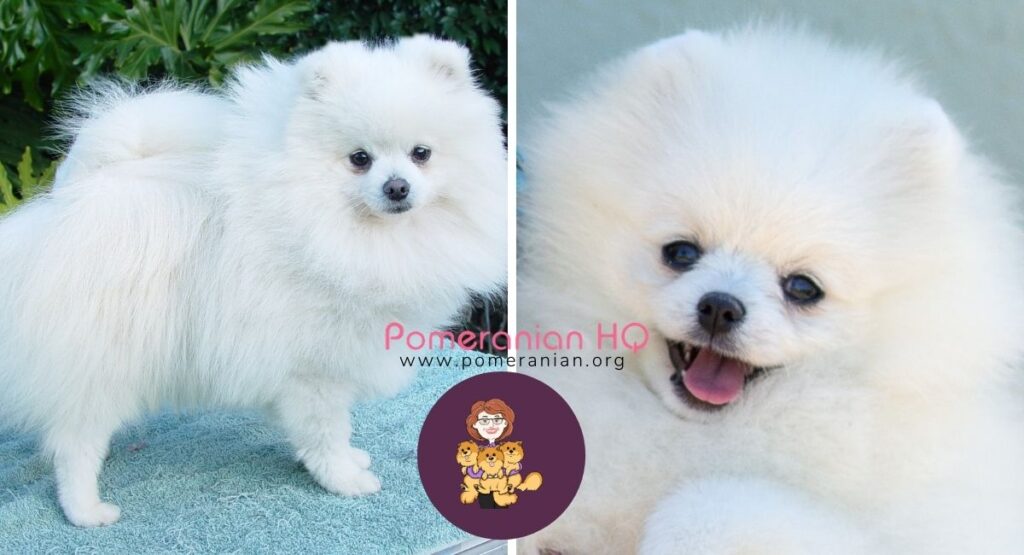
Copyright Pomeranian.org. All Rights Reserved.
References and Further Reading:
[1] Official Standard of the Pomeranian (AKC). American Kennel Club, 2011.
[2] Official English Kennel Club Pomeranian Breed Standard, 2017.
[3] Kimbering Pomeranians “1891-1991”.
[4] Denise Leo, The Pomeranian Handbook.
[5] E.Parker, The Popular Pomeranian.
[6] L.Ives, Show Pomeranians.
The Pomeranian Handbook
